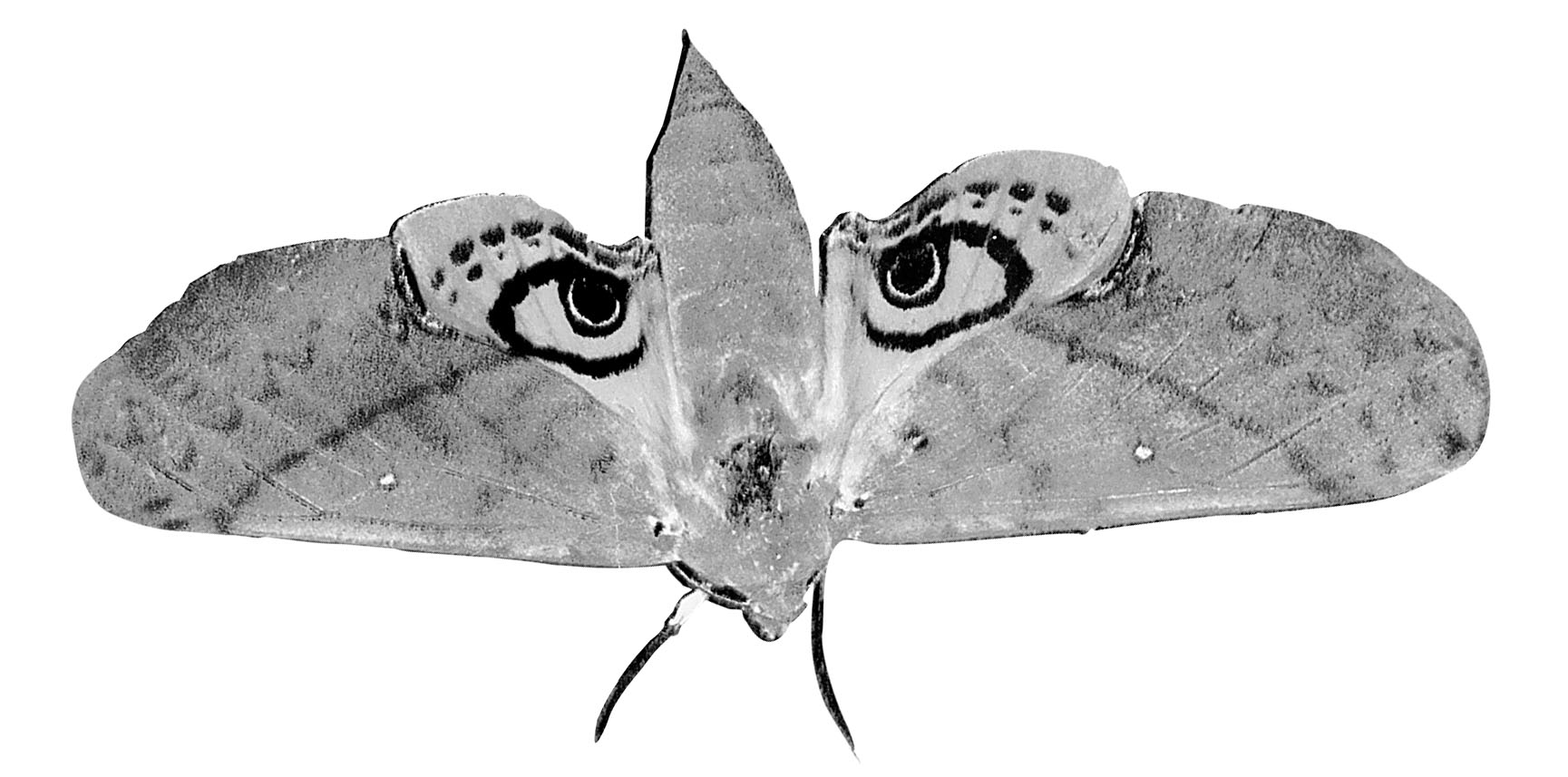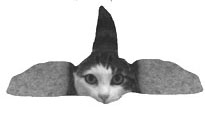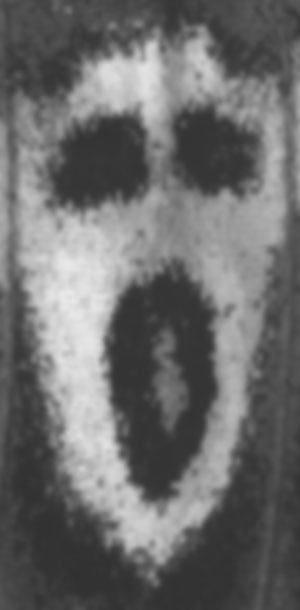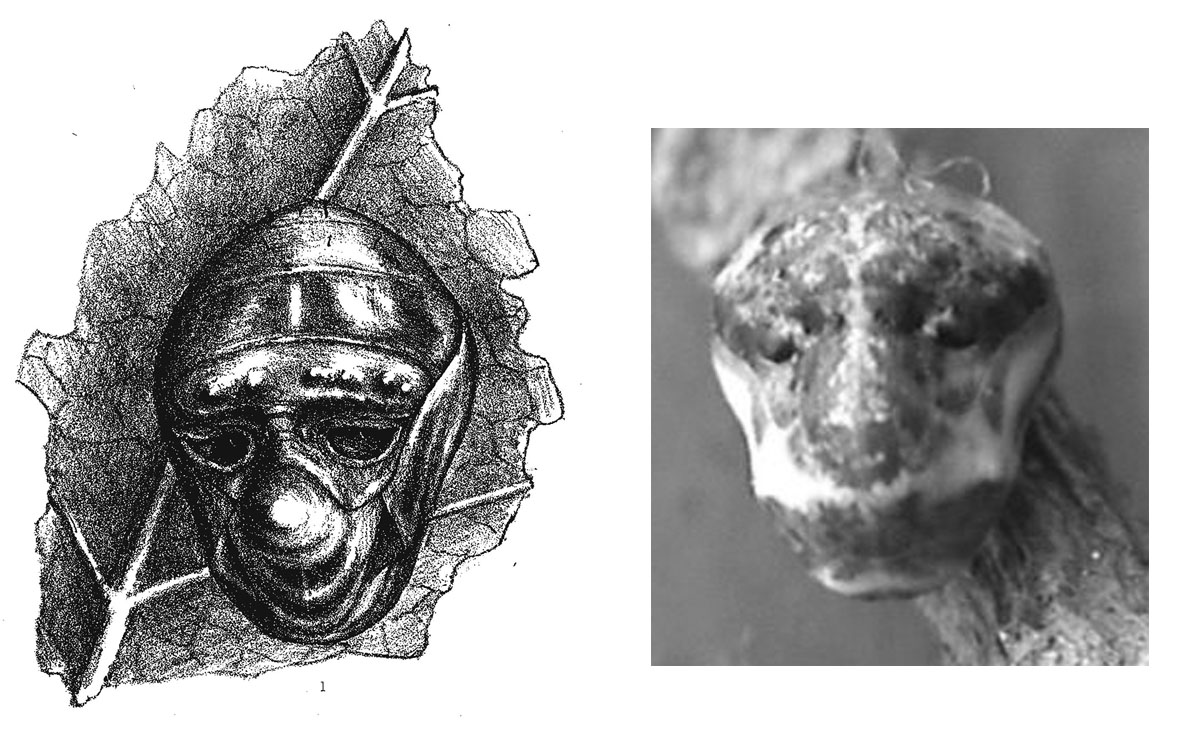Copyright © 2007-2018 Russ Dewey
Predator-Prey Arms Races
The constant competition between predators and prey animals is a major stimulus to evolution, sometimes called an evolutionary arms race. Predators adapt to prey populations, and prey populations adapt to innovations of a predator.
Bats have a very effective system for locating insects, using high-frequency sonar that bounces off insects and provides directional information. Bats are also excellent flyers capable of turning on a dime. Insects that cannot escape the bats are more likely to be eaten.
Insects that develop a genetic mutation that reduces the chance of bat predation are more likely to survive and reproduce. For example, the Noctuid moth has a simple three-neuron auditory system tuned to the frequency of the bat's sonar.
When the neurons fire (indicating a bat is nearby) this triggers a motor program. The moth dives suddenly into grass, where it is safe from bats.
The praying mantis–itself a predator for many smaller insects–is just prey to bats. So the praying mantis evolved a special ear in the middle of its thorax, tuned to the exact frequency of the sound emitted by bats.
When stimulated, the receptor triggers a "sudden full extension of its forelegs" and contraction of the abdomen leading to "an abrupt and dramatic deviation in its flight path" (Yager and Hoy, 1986). This helps mantises avoid being eaten.
What is an example of an evolutionary "arms race" involving bats and their prey?
As prey species evolve successful defenses, predator species evolve better techniques for hunting. Some bats employ unusual echo frequencies, so they overcome specialized defense systems tuned to the usual frequency of bat sonar.
Some bats use non-echo hunting strategies, so they can catch insects that have defenses only against the echolocation strategy. The predator-prey competition stimulates innovation on both sides.
How do some bats overcome the defense strategies?
Animals commonly have built-in circuits to trigger avoidance of danger. For example, a Central American bird called the motmot preys on snakes, but it must avoid the poisonous coral snake. Coral snakes have a distinctive color pattern of red, yellow and black rings. Motmots are born with a fear of this pattern.
Smith (1975) reared some motmots by hand to insure they never saw a coral snake. She then exposed them to a series of models: wooden tubes painted rings or stripes of various colors. She reported:
What was Smith's experiment with hand-reared motmots?
The motmots had no hesitation in pecking at plain red, yellow, green, blue or unpainted wooden models. However, the bird's initial reaction to the solid yellow and red ring model was one of avoidance: all flew up to the opposite corner of the cage and in many cases gave alarm notes. (p.759)
The avoidance behavior, in response to a highly specific stimulus, follows the pattern of motor programs set off by releasers. Birds have small brains and often economize by responding to highly specific stimuli.
Eye Spots
Insects preyed upon by birds often have patterns of pigment that resemble eyes. Eyespots scare birds away or divert their pecks to the eyespot on a wing instead of the body.
Tiny eyespots can scare birds because birds are expert at recognizing visual patterns, but they are relatively insensitive to the size of a pattern. They fly at various altitudes, so the size of a significant pattern can vary greatly.
Humans adjust their perception of size to compensate for apparent distance. This was mentioned in Chapter 4; it is called Emmert's Law.
Implementing Emmert's Law requires neural circuitry for calculating size and distance. Birds save on computing power by responding more to patterns than size.
This gives prey insects an evolutionary opportunity. Insects that develop a pattern resembling an eye spot are less likely to be eaten. Consequently they are more likely to reproduce and pass on the eye-spot genes.
Why do some moths have eyespots on their wings?
Why are birds instinctively afraid of eyespots? Predators, as a rule, have large front-facing eyes. This helps them localize their prey in space using binocular disparity.
Animals that prey on birds, such as owls, primates, and cats, all have large, front-facing eyes. Birds with an instinct to avoid those eye patterns are more likely to survive and reproduce.

The Hawk Moth
Above is the Hawk Moth of New Caladonia. The name Hawk Moth is apt, but one student suggested Tiger Moth might be more appropriate. The forward-facing eyes and rounded nose look feline. Cats love to prey on birds, so a pattern like this might scare birds.

No moth looks as cat-like as the Rosie moth.
I added the illustration above, the Rosie moth, as a surprise for my daughter when she took my intro class in the 1990s. Rosie was her first cat, and this was a quick Photoshop job.
A student emailed me (after the textbook was first posted online in 2007) to chastise me for not labeling the figure as a joke. "It might confuse some students." OK; it is a joke. The Hawk Moth, on the other hand, really exists.
There is a second way eyespots protect butterflies, besides scaring them away. Birds that attack insects often peck at the eyes as a vulnerable spot. If they peck an eyespot instead, the butterfly or moth flies away.
Swynnerton painted conspicuous eyespots on butterflies visiting clumps of bananas next to his verandah. He caught the painted butterflies later and observed that 47 of 51 butterflies had injuries from bird pecks.
Of the 47 injuries, 36 were at or near the eyespots (Cott, 1940/1957). A peck on the eyespot may reduce the butterfly's flying efficiency, but at least the butterfly can survive to reproduce.
What was Swynnerton's experiment?
Eyespots are common among butterflies and moths. They have attracted considerable research attention.
A team at the University of Wisconsin identified specific genes and proteins that controlled eyespot formation (Carroll, Gates, Keys, Paddock, Panganiban, Selegue, and Williams, 1994).
What did Wisconsin researchers discover about eye spots?
Within a few years, they identified a specific sequence of changes in gene expression that led to the evolution of eyespots (Keys, Lewis, Selegue, Pearson, Goodrich, Johnson, Gates, Scott, and Carroll, 1999). The famous hedgehog signaling pathway was involved.
Elaborate Visual Mimicry

Pigment on a butterfly wing
Sandved (1981) came across a butterfly in Thailand with a repeated pattern of pigment that bears a remarkable resemblance to a small monkey face (right). It is only about as big as a pencil eraser, and it is repeated along the edge of the butterfly wing.
Monkeys are predators of birds in Thailand. This could be a way to scare birds that might eat the butterfly.
How does such an accurate "picture" evolve?
A monkey face is also found on the chrysalis of the butterfly spalgis epius or apefly, shown next.

Chrysalis of the spalgis epius butterfly
Presumably the first occurrence of the pattern was much cruder than this, a lucky accident that helped the chrysalis avoid being eaten by birds. With succeeding generations, the pattern was refined.
Chrysali with a cruder (less face-like) patterns were eaten by birds. The more face-like the pattern, the more likely the butterfly was to survive and reproduce. Eventually the artwork became quite accurate.
This example is so dramatic that it could easily provoke skepticism. After all, it is a sketch, not a photograph. Might the unknown artist have taken some liberties?
However, the spalgis epius has the nickname apefly, so the resemblance has been remarked-upon for a long time. A second illustration of the apefly, below left, comes from an 1892 article in the journal Psyche.
The Wikimedia public domain art project has a photo of the apefly (bottom right) looking more like a dragon or lion. Comparing the three samples shows that the pattern has a lot of variability.
That helps to explain how the pattern could be shaped up by variable predation rates. If you are an apefly who looks less scary, you are more likely to be eaten.

Two more examples of the apefly chrysalis
These are all examples of visual mimicry or imitation. Humans are highly visual animals, like birds. Like birds, we cannot help but see a face in a few blotches of pigment on the spalgis epius chrysalis.
Our brains respond to significant visual patterns automatically. Other species respond more to mimicry of odors, textures, and sounds. Mimicry of odor and sound are widespread in nature but less compelling to humans.
---------------------
References:
Carroll, S. B., Gates, J., Keys, D. N., Paddock, S. W., Panganiban, E. F., Selegue, J. E., & Williams, J. A. (1994) Pattern formation and eyespot determination in butterfly wings. Science, 265, 109-114.
Cott, H. B. (1940/1957). Adaptive Coloration in Animals. London: Methuen.
Keys, D., Lewis, D., Selegue, J., Pearson, B., Goodrich, L., Johnson, R., Gates, J., Scott, M. & Carroll, S. (1999). Recruitment of a hedgehog regulatory circuit in butterfly eyespot evolution. Science, 283, 532-534.
Smith, S. M. (1975). Innate recognition of a coral snake pattern by a possible avian predator. Science, 187, 759-760.
Yager, D. D. & Hoy, R. R. (1986). The Cyclopean Ear: A new sense for the praying mantis. Science, 231, 727-729.
Write to Dr. Dewey at psywww@gmail.com.
Don't see what you need? Psych Web has over 1,000 pages, so it may be elsewhere on the site. Do a site-specific Google search using the box below.
